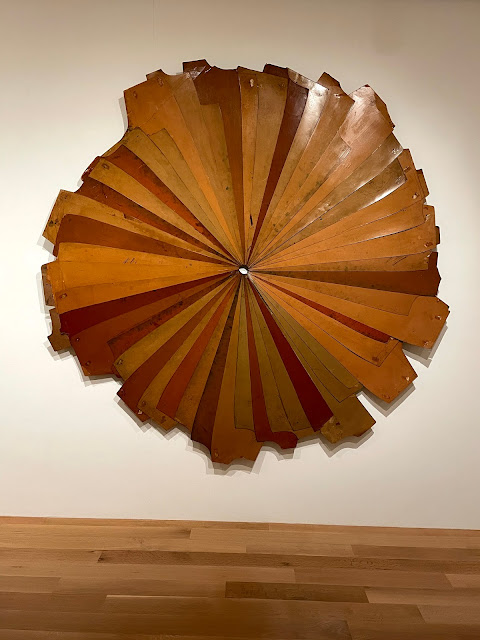As the mother of an artist,
I can't help but have an appreciation of the creative process and
how it works, or doesn't work, for each creator -
whether their expressive form is the written or spoken word,
painting, sculpture, collage or a combination of multiple mediums.
I can guess the effort that goes into every piece
and the courage it takes to see something of yours completed
and sent into the world.
In my mind, it would be like standing naked every day,
saying here I am; take it or leave it.
There's such an exquisite vulnerability that stands along every piece of art;
I wonder if people who casually walk among works in museums have any clue.
That being said, I don't know much about why some things work together
and why others don't.
I don't know how the 'art world' judges or prioritizes what's worthy of acclimation
and what isn't.
As the vernacular has it,
"I know what I like."
and
"Beauty is in the eye of the beholder".
A recent exhibit at the Pulitzer Arts Foundation,
highlighting works by Terry Adkins, spoke to me on several levels
and has kept me thinking abut what I saw for several weeks now.
I was unfamiliar with this particular artists work
and am still not familiar with the breadth of all he created.
Adkins was raised in a 'musical household' in Alexandria, VA (in 1953)
where he learned to play piano and saxophone.
He was drawn to music, especially jazz
even while turning his focus to visual art,
earning degrees in fine art and printmaking.
He referred to himself as a 'composer',
applying principles of improvisation and experimentation that he learned through jazz
to his approach to art making.
"My quest has been to find a way to make music as physical as sculpture might be
and sculpture as ethereal as music is.
It's kind of challenging to make both of those pursuits do
what they are normally not able to do."
"He was drawn to gathered objects that others considered 'scraps'
which he brought home and lived with until they revealed their purpose",
says the booklet that accompanied his exhibit.
This description made me smile -
what a wonderful way to say he was a dumpster diver
who lived with other peoples garbage. :)
I know and love some folks just like him.
The ability of seeing beauty in what others discard is a gift;
the select few who have that talent are visionaries.
I can't tell you how familiar this rosary draped figure felt to me;
I've seen it before on several 'art altars' in different studios.
This was from his personal collection of memorabilia and cultural artifacts.
He was also a prolific reader, beginning in middle school
when he began collecting copies of Dante Alighieri's Divine Comedy;
eventually gathering dozens of copies of the book
Honestly, who sees a thrown away patio chair and thinks,
"I know; lets weave some reeds through it and call it sculpture?"
and put it on a deck?
As an African American artist,
Adkins
explored the intersection of blues music and the Great Migration,
a
period during which millions of black Americans moved from the South
to
metropolitan centers of the north, Midwest and eastern United States.
He
created the pieces below during a residency in Texas,
in a building which had decades worth of mechanical and textile scraps stored -
which he repurposed into art.This piece was created from wooden pants patterns -
each 'petal' was a different inside seam length...
genius, right?
I honestly don't remember anything about this piece (below)
except how much I loved it.
In my mind its very evocative of Egyptian imagery and symbolism.
I could be totally off base -
but that's the wonder of art, isn't it?
Who can tell me I'm wrong?
Without a doubt, though, my favorite piece was entitled Infinity.
Adkins longest running work was born out of an act of repentance.
When Adkins was 19 years old, he stole a copy of John Coltrane's album, Infinity (1972)
from a Nashville record store.
Consumed by guilt, he decided to atone for his indiscretion
by buying a copy of the record every time he encountered it
for the rest of his life.
Here, 75 records rest in a vintage trunk
whose starburst lining complements the psychedelic album covers.
The motivations behind pieces of art are rarely as clearly articulated as this;
but this is such a powerful example of 'emotional baggage' made manifest
that it's fascinating to me.
I'm so glad I was able to see this exhibit especially in the midst of a pandemic.
Beauty and thoughts of what lives on beyond our own time on this earth
are enterprises worthy of our time and attention.









No comments:
Post a Comment